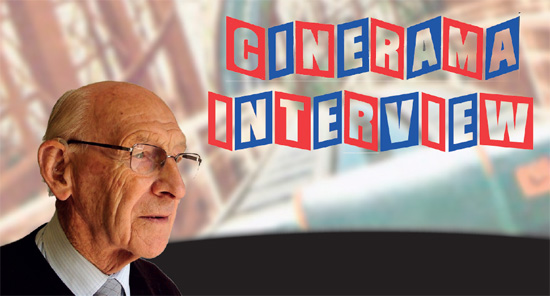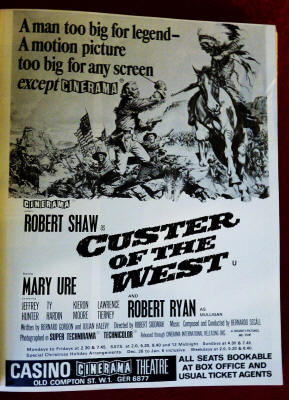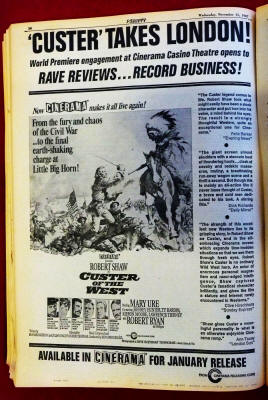Ken Draper interviewed |
Read more at in70mm.com The 70mm Newsletter |
| Written by: Mikael Barnard. Content copyright: The Projected Picture Trust. Reprinted with permission | Date: 09.02.2017 |
 Ken
Draper. Picture from the PPT Ken
Draper. Picture from the PPTWe are very lucky at the PPT to have at our disposal an astounding and prodigious pool of expertise in a wide number of fields related to our activities and mission. Our curator is surely one of our greatest assets and he brings a tremendous wealth of experience and knowledge concerning the technological history of cinema. Among his many achievements can be listed his time as a Cinerama projectionist at the London Casino where he was present at no less an occasion than the format’s UK début. In this anniversary year Ken was kind enough to share the following reminiscences. |
More in 70mm reading: in70mm.com's Cinerama page This is Cinerama...at the London Casino DP70 at the Casino in London PDF: Ken Draper interview Internet link: ppttrust.org |
|
How did you come to be a Cinerama projectionist and what training was required? I answered an advert in Kine Weekly – Cinerama projectionist wanted for the London Casino, only chiefs or first projectionists need apply! I started work at the Casino on 19 September 1954, eleven days before opening night on 30 September. We had to pick it up quickly but we did many rehearsals and were well prepared. How difficult was it as a system, particularly to make up? As you probably know at the Casino each panel (Abel, Baker and Charlie) was operated from separate boxes. Abel and Charlie boxes were a pretty decent size but Baker box was rather squeezed in the middle. The films for each panel arrived on individual 8000ft spools; there would be two of these per box and they were changed during the interval. These were fitted with academy style leaders (with Ken Draper interviewed by Mikael Barnard each frame being six perforations high of course) and we would lace up to the start mark. Did you ever experience any breakdowns? If so how was replacement footage required and how was this dealt with? We had a chap named Les Gardiner responsible for dealing with damage and repairs and he had a separate room. When I was there projectionists worked two shifts, we never had a breakdown on my shift and I never heard of one on the other. Nevertheless, the repair man was kept busy examining the films for damage and keeping them clean. When a particular section looked to be getting a bit worn a replacement section would be ordered from America, these usually ran from fade-out to fade-out, the Cinerama travelogues being well suited to this. How was the Cinerama equipment at the Casino laid out? We had the three boxes – Abel, Baker and Charlie and the ‘spot box’. This was at the top of the Casino and housed the projector for the This is Cinerama prologue and the sound equipment. |
|
 The
Casino in London playing
"Custer of the West" in Super Technirama 70 as a CINERAMA release. Picture
from the PPT The
Casino in London playing
"Custer of the West" in Super Technirama 70 as a CINERAMA release. Picture
from the PPTDid you run Cinerama anywhere other than at the Casino? No. I started with the début screening of "This is Cinerama", and then in 1956 we ran "Cinerama Holiday". I left in 1957 for a job at MGM British Studios at Borehamwood where I worked in the preview theatre, post sync theatre and in the music/sound dubbing department. Cinerama screenings, particularly in the earliest days, were notoriously well sold. Were you always sold out at the Casino? Yes, in the early days we always had full houses. One particularly memorable screening of "This is Cinerama" that I was involved with saw the Queen and Prince Philip in attendance. Front of house management would deal with the day-today business of ticket sales. A set amount were held back for purchasing ‘on the door’ – the Casino was still treated as a theatre and Cinerama involved individual programmes, not continuous shows as was standard practice in general cinemas. I cannot recall if there was a waiting list as such but then it wasn’t my department. One piece of equipment seen in documentary footage of American Cinerama theatres at the time shows special cranes for lifting the reels into the spool boxes, did you have these at the Casino? We had no cranes at the Casino. We had to lift the spools manually and would swing them up! How was the equipment synchronised at start-up? Was it with a mark on leader like sound on disc? The cross on the projectors was first set in the usual fashion. All the equipment was interlocked with Selsyn motors and everything was set off by the man at the control console which was in front of Baker box in the cinema, another reason Baker box was so truncated. There was a talk-back system between the projectionists and the controller. We had a cue switch in the box, when we were ready we would flip this and a light would appear on the controller’s desk. He would get four lights – Abel, Baker, Charlie and the sound box. Once this was done the only thing left for us to do was check the cooling pumps and strike the arc. Initially I was in charge of Abel box but later I was promoted to the sound box (the old spot box) where I was responsible for the seven track magnetic soundtrack and the 35mm projector used for the This is Cinerama prologue. The controller would flip a switch when he wanted it to start, a little light would come on in the box and that was my cue. I would run the projector and as the picture came onto the screen the controller would open the curtains to a 4×3 ratio. Towards the end of the prologue the controller would start the other three projectors running, the projectionists would open their dowsers and the controller would hit the button for the electronic shutter and open the curtains to their full width just after Lowell Thomas announced ‘Ladies and gentlemen, this is Cinerama.’ Ken, thank you so much for sharing your Cinerama experience with us. Content copyright: The Projected Picture Trust. |
|
| Go: back - top - back issues - news index Updated 22-01-25 |


